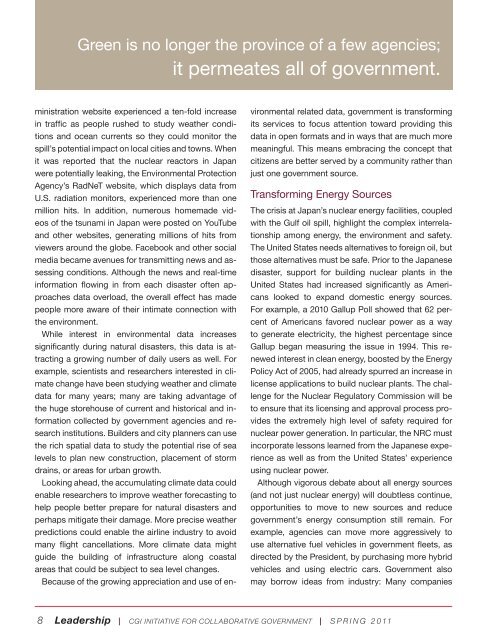Government's Sustainability Moment - CGI Initiative for Collaborative ...
Government's Sustainability Moment - CGI Initiative for Collaborative ...
Government's Sustainability Moment - CGI Initiative for Collaborative ...
Create successful ePaper yourself
Turn your PDF publications into a flip-book with our unique Google optimized e-Paper software.
Green is no longer the province of a few agencies;it permeates all of government.ministration website experienced a ten-fold increasein traffic as people rushed to study weather conditionsand ocean currents so they could monitor thespill’s potential impact on local cities and towns. Whenit was reported that the nuclear reactors in Japanwere potentially leaking, the Environmental ProtectionAgency’s RadNeT website, which displays data fromU.S. radiation monitors, experienced more than onemillion hits. In addition, numerous homemade videosof the tsunami in Japan were posted on YouTubeand other websites, generating millions of hits fromviewers around the globe. Facebook and other socialmedia became avenues <strong>for</strong> transmitting news and assessingconditions. Although the news and real-timein<strong>for</strong>mation flowing in from each disaster often approachesdata overload, the overall effect has madepeople more aware of their intimate connection withthe environment.While interest in environmental data increasessignificantly during natural disasters, this data is attractinga growing number of daily users as well. Forexample, scientists and researchers interested in climatechange have been studying weather and climatedata <strong>for</strong> many years; many are taking advantage ofthe huge storehouse of current and historical and in<strong>for</strong>mationcollected by government agencies and researchinstitutions. Builders and city planners can usethe rich spatial data to study the potential rise of sealevels to plan new construction, placement of stormdrains, or areas <strong>for</strong> urban growth.Looking ahead, the accumulating climate data couldenable researchers to improve weather <strong>for</strong>ecasting tohelp people better prepare <strong>for</strong> natural disasters andperhaps mitigate their damage. More precise weatherpredictions could enable the airline industry to avoidmany flight cancellations. More climate data mightguide the building of infrastructure along coastalareas that could be subject to sea level changes.Because of the growing appreciation and use of en-vironmental related data, government is trans<strong>for</strong>mingits services to focus attention toward providing thisdata in open <strong>for</strong>mats and in ways that are much moremeaningful. This means embracing the concept thatcitizens are better served by a community rather thanjust one government source.Trans<strong>for</strong>ming Energy SourcesThe crisis at Japan’s nuclear energy facilities, coupledwith the Gulf oil spill, highlight the complex interrelationshipamong energy, the environment and safety.The United States needs alternatives to <strong>for</strong>eign oil, butthose alternatives must be safe. Prior to the Japanesedisaster, support <strong>for</strong> building nuclear plants in theUnited States had increased significantly as Americanslooked to expand domestic energy sources.For example, a 2010 Gallup Poll showed that 62 percentof Americans favored nuclear power as a wayto generate electricity, the highest percentage sinceGallup began measuring the issue in 1994. This renewedinterest in clean energy, boosted by the EnergyPolicy Act of 2005, had already spurred an increase inlicense applications to build nuclear plants. The challenge<strong>for</strong> the Nuclear Regulatory Commission will beto ensure that its licensing and approval process providesthe extremely high level of safety required <strong>for</strong>nuclear power generation. In particular, the NRC mustincorporate lessons learned from the Japanese experienceas well as from the United States’ experienceusing nuclear power.Although vigorous debate about all energy sources(and not just nuclear energy) will doubtless continue,opportunities to move to new sources and reducegovernment’s energy consumption still remain. Forexample, agencies can move more aggressively touse alternative fuel vehicles in government fleets, asdirected by the President, by purchasing more hybridvehicles and using electric cars. Government alsomay borrow ideas from industry: Many companies8 Leadership | <strong>CGI</strong> INITIATIVE FOR COLLABORATIVE GOVERNMENT | S P R I N G 2 0 11


